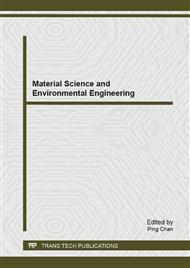[1]
Zouboulish A I, Loukidou M, Matis K A. Biosorption of toxic metals from aqueous solutions by bacteria strains isolated from metal polluted soils [J]. Process Biochemistry, 2004, 39: 909-916.
DOI: 10.1016/s0032-9592(03)00200-0
Google Scholar
[2]
Ghinwa Naja, Bohumil Volesky. The mechanism of metal cation and anion biosorption[J]. Microbial Biosorption of Metals, 2011, 1: 19-58.
DOI: 10.1007/978-94-007-0443-5_3
Google Scholar
[3]
Çabuk A, Akar T, Tunalı S, et al. Biosorption characteristics of Bacillus sp. ATS-2 immobilized in silica gel for removal of Pb(Ⅱ)[J]. Journal of Hazardous Materials, 2006 136: 317-323.
DOI: 10.1016/j.jhazmat.2005.12.019
Google Scholar
[4]
Vieira RHSF, Volesky B. Biosorption: a solution to pollution [J]. International Microbiology, 2010, 3(1): 17-24.
Google Scholar
[5]
Yi H, Wu L, Bentley W E, et al. Biofabrication with chitosan[J]. Biomacromol, 2005, 9: 2881-2894.
Google Scholar
[6]
Cheung W H, Szeto Y S, McKay G. Enhancing the adsorption capacities of acid dyes by chitosan nano particles[J]. Bioresource Technology, 2009, 100: 1143-1148.
DOI: 10.1016/j.biortech.2008.07.071
Google Scholar
[7]
Ding P, Huang K L, Li G Y. Kinetics of adsorption of zn(Ⅱ) ion on chitosan derivatives [J]. International Journal of Biological Macromolecules, 2006, 39: 222-227.
DOI: 10.1016/j.ijbiomac.2006.03.029
Google Scholar
[8]
Pillai C K S, Paul W, Sharma C P. Chitin and chitosan polymers: Chemistry, solubility and fiber formation [J]. Progress in Polymer Science, 2009, 34(7): 641-678.
DOI: 10.1016/j.progpolymsci.2009.04.001
Google Scholar
[9]
Elwakeel K Z, Atia A A, Donia A M. Removal of Mo(Ⅵ) as oxoanions from aqueous solutions using chemically modified magnetic chitosan resins [J]. Hydrometallurgy, 2009, 97: 21-28.
DOI: 10.1016/j.hydromet.2008.12.009
Google Scholar
[10]
Lee J W, Lee S M, Huh Y D, et al. EDTA surface capped water-dispersible ZnSe and ZnS: Mn nanocrystals [J]. Bulletin of Korean Chemical Society, 2010, 31(7): 1997-(2002).
DOI: 10.5012/bkcs.2010.31.7.1997
Google Scholar
[11]
Hinck M L, Ferguson J. Resistance of EDTA and DTPA to aerobic biodegradation [J]. Water Science and Technology, 1997, 35 (2): 25~31.
DOI: 10.2166/wst.1997.0474
Google Scholar
[12]
Zhou Z L, Qiu R L, Zhang W H, et al. The study of operating variables in soil washing with EDTA [J]. Environmental Pollution, 2009, 157(1): 229-236.
DOI: 10.1016/j.envpol.2008.07.009
Google Scholar
[13]
Zaier H, Ghnaya T, Rejeb K B, et al. Effects of EDTA on phytoextraction of heavy metals (Zn, Mn and Pb) from sludge-amended soil with Brassica napus [J]. Bioresource Technology, 2010, 101(11): 3978-3983.
DOI: 10.1016/j.biortech.2010.01.035
Google Scholar


